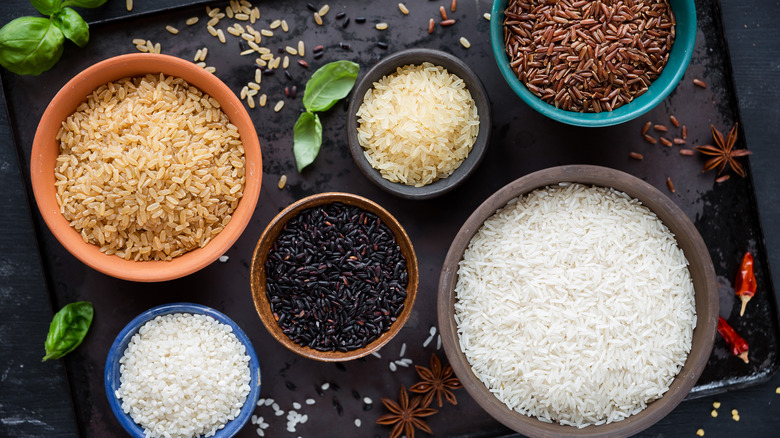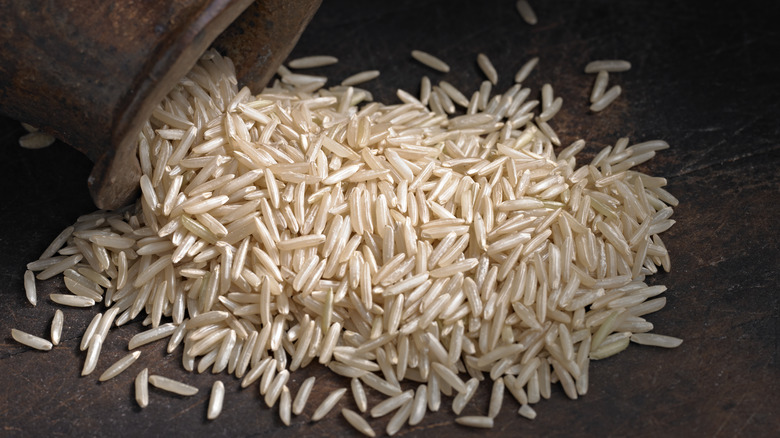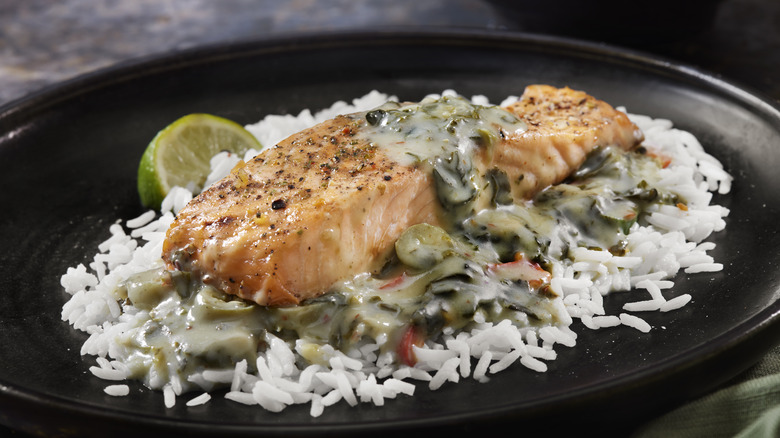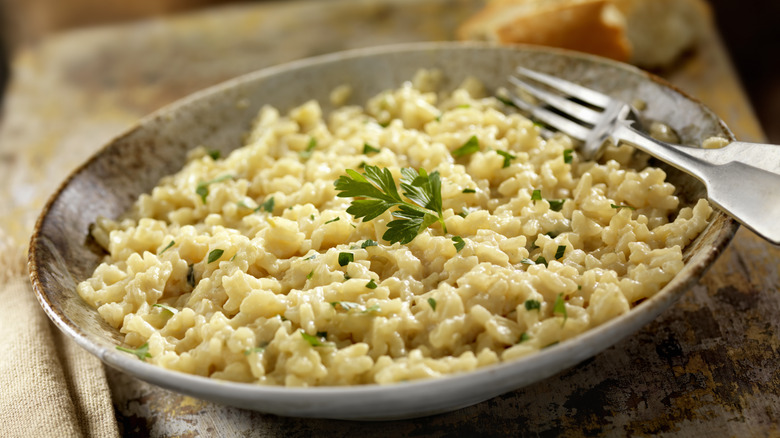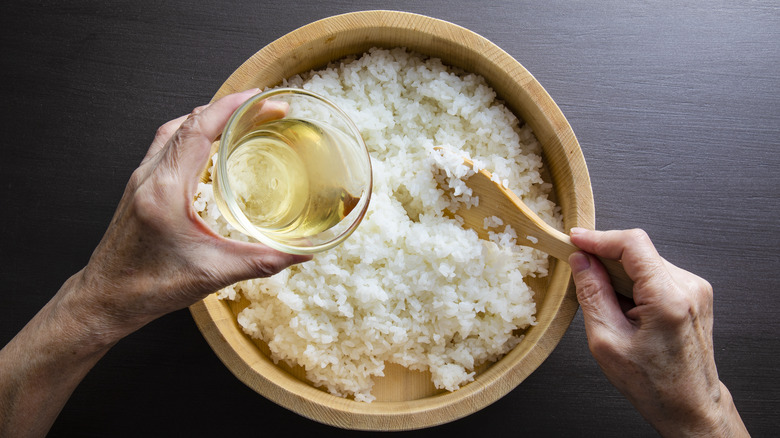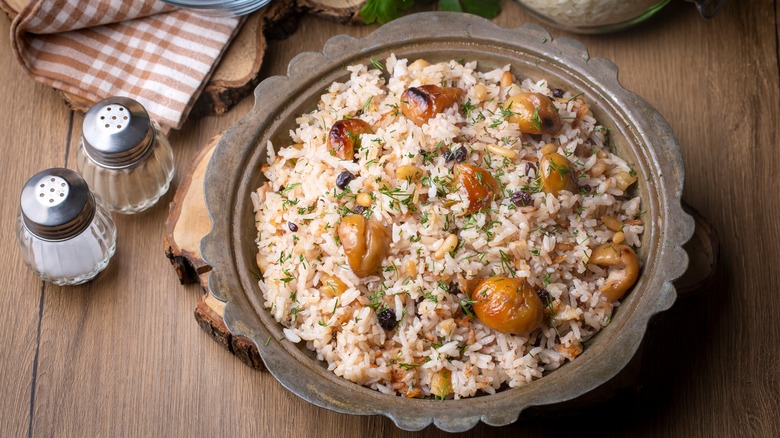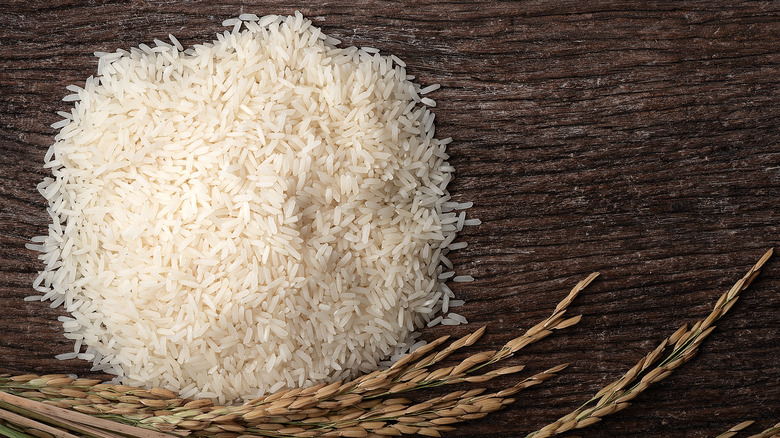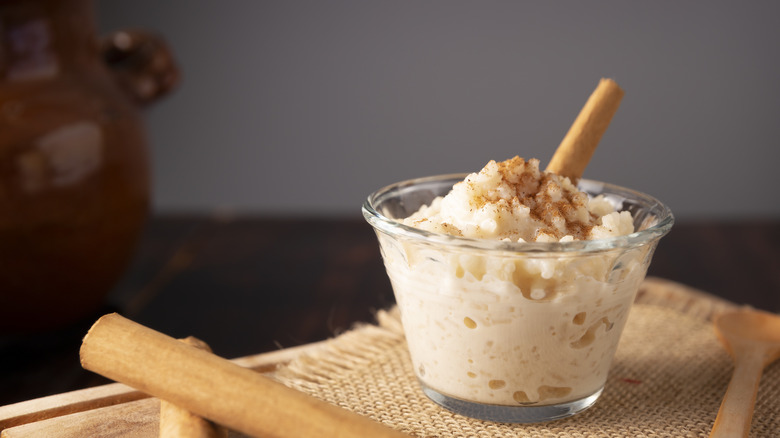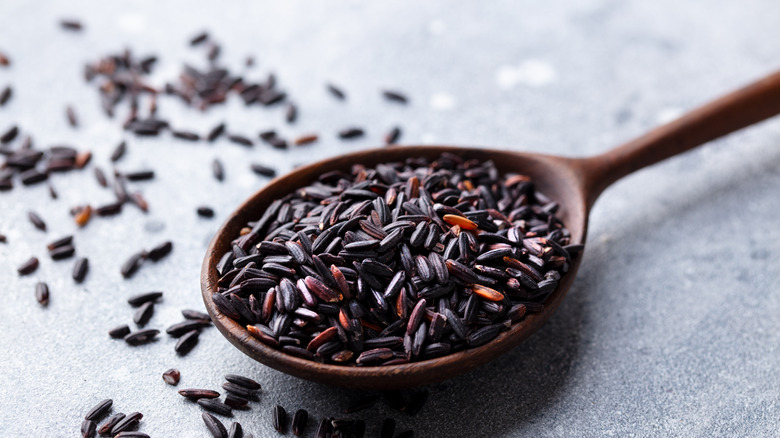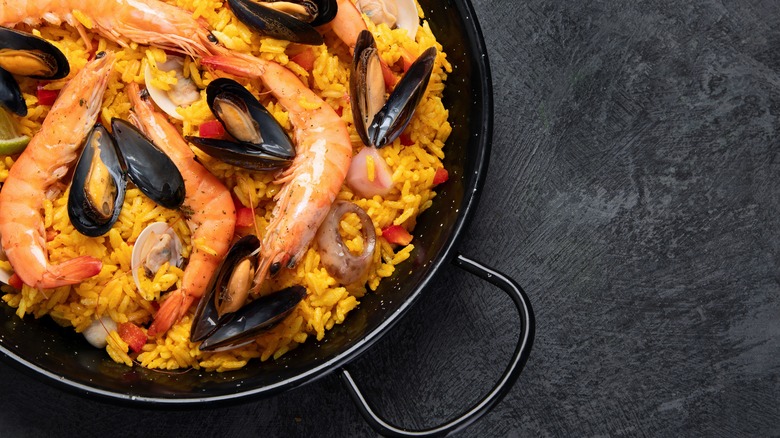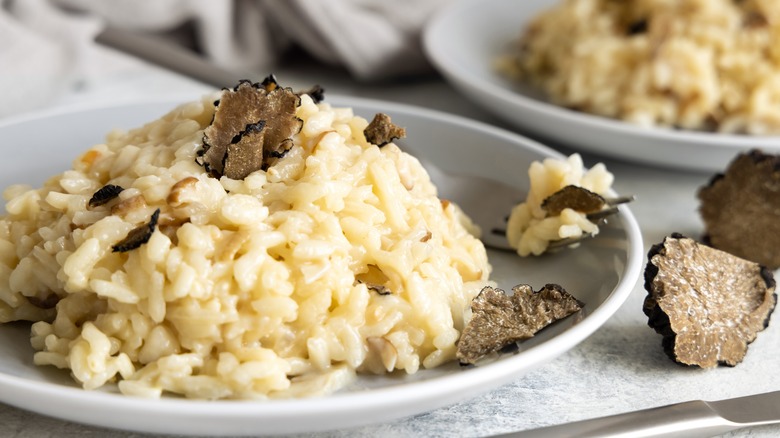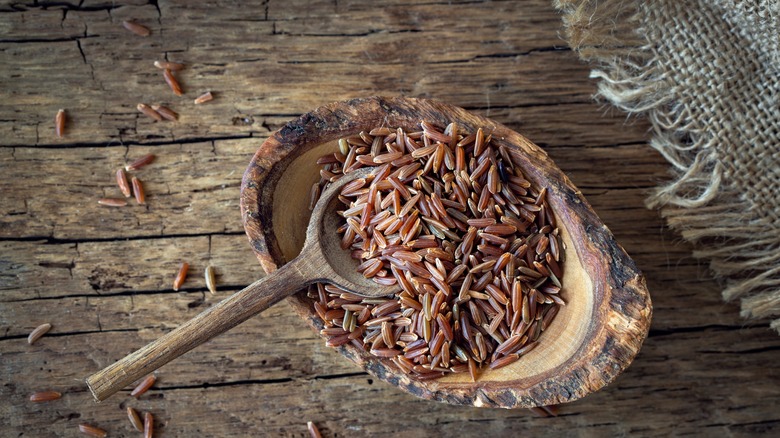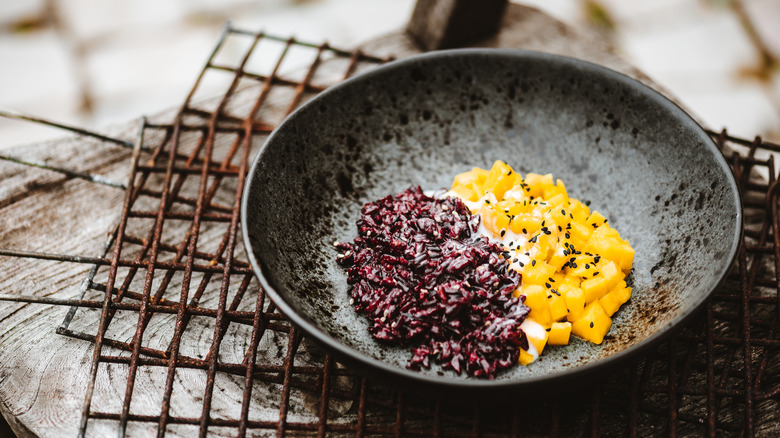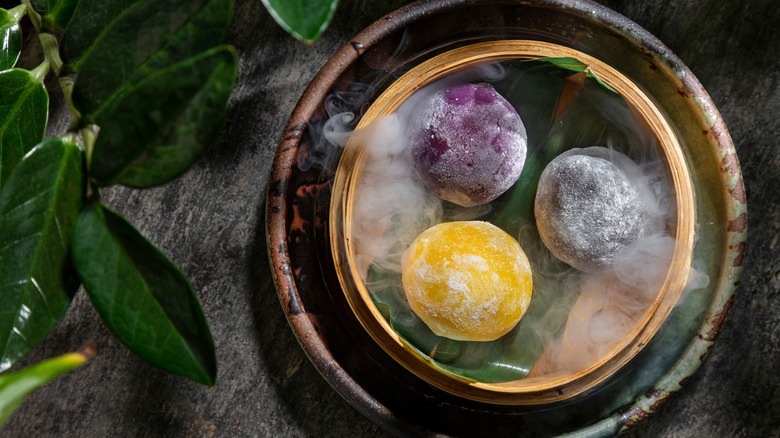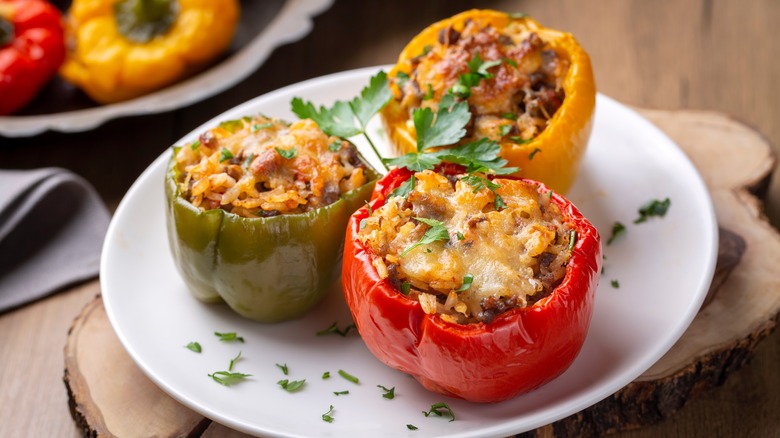14 Types Of Rice And The Best Dishes To Use Them In
Rice is a versatile staple ingredient in global cuisine and an everyday part of the world's daily meals. In the 2022/2023 crop year over 520 metric tons of rice were consumed (via Statista), with more than 50% of people on the planet getting 20% of their daily calorie intake from rice alone (per World Population Review).
In the U.S., every person consumes an average of 27 pounds of rice annually. Depending on the variety, rice is packed with nutrition and good-for-you carbohydrates. Carbohydrates are the main source of fuel in the body, and they are an essential part of a balanced diet. Rice also has fiber, selenium, magnesium, and plenty of B vitamins, which affect energy levels and brain function.
But, plain rice can get a little boring. If you're used to a dull plate of buttered white rice, you've not unlocked the multitudes of rice types, and the possibilities therein. If you're ready to explore more options, here are 14 different types of rice, and the dishes (and cuisines) in which they are best used.
From late nights hunched over takeout containers to rainy Sunday mornings spent poring over cookbooks from all corners of the globe, I have years of experience tasting and cooking with rice. I also scoured the internet for tidbits of facts, figures, and useful information to help provide the fullest possible picture of each rice type.
Basmati rice
Basmati rice is a fragrant staple in Indian, Pakistani, and Middle Eastern cuisines. It is a long-grain rice grown primarily in India and Pakistan known for its distinct aroma and delicate flavor. Each grain is elongated and cooks up fluffy and soft without being sticky.
The aroma is distinctive, often described as nutty or similar to popcorn. Basmati rice has the same compounds in pandan leaves ( that produce this aroma and contribute to a mildly nutty taste. Another distinctive feature is the long, slim grain. As they cook, they get even longer and stay separated. This unique characteristic is perfect for cooking a pilaf or biryani.
Basmati rice is also excellent for Persian crispy rice, or tahdig. This dish is cooked until the rice forms a crispy golden crust on the bottom. It's then flipped out of the pot and studded with everything from cherries to ground lamb. Another dish that takes advantage of the crispy crust is tahchin, a thick, layered rice dish with a crispy crust and layers of meat and vegetables. But, don't skip dessert: Basmati rice also makes a decadent rice pudding.
Jasmine rice
Jasmine rice is a fragrant, medium-grain variety grown mostly in Thailand. Shorter and fatter than basmati, it is sometimes mistaken for its fragrant cousin due to its similar flavor and smell. Jasmine rice is softer than basmati after cooking and is slightly sticky. This means that grains may cling together.
Jasmine rice is featured in Southeast Asian dishes, including Thai curries and stir-fries. It's also a solid choice for fried rice and can be used in sushi (although short-grain sushi rice is better). Some cooks use jasmine rice for sweet mango rice or rice pudding, especially when prepared with coconut milk. The sweetness in this rice pairs nicely with the subtle sweetness of coconut milk.
Although all rice has a long shelf life, some lose their flavor over time. Jasmine rice is one of these. Fresh or "new crop" jasmine rice is more expensive, but the flavor and aroma will be more pronounced than older rice. For the most flavorful results, get the freshest rice possible.
Arborio rice
Arborio rice is most famous for its use in risotto, an Italian dish with a luscious texture. This rice has a short, starchy grain and is named after the town of Arborio in the Po Valley of Italy, where it originated. It is pearly white and absorbs liquids evenly. When simmered and stirred constantly, the starch in the rice releases, creating the creamy texture risotto is famous for.
It's a delicate balance, cooking Arborio rice into risotto. The rice should be toasted first to highlight its flavor; next, ladles of hot stock or broth should be added and the rice stirred until the stock or broth is nearly absorbed. Continue adding ladles of liquid until absorption slows. Take care towards the end of the cooking process. Overcooked risotto is mushy and inedible. A quick and easy test is to take a single grain of rice and smear it along a cutting board. The rice should smear easily but have a single dot of white at the center. Additions such as seafood, vegetables, and herbs, such as butternut squash and sage, can be added at the end of cooking or placed on the risotto when served.
Risotto is not the only dish for which Arborio rice is well-suited. It can also be used in rice pudding and paella, too. Arborio rice's ability to absorb flavors means each grain picks up the flavor of whatever you're cooking.
Sushi rice
Short-grained sushi rice is, as its name would imply, the rice of choice for sushi, nigiri, sushi bowls, and various other Japanese-style raw fish dishes. The rice variety may be koshihikari, hitomebore, or akitakomachi, but it is more commonly called sushi rice in American grocery stores.
Sushi rice is sticky and clumps together, perfect for hand-forming rice logs for sushi. But, those logs aren't just rice. Making rice for sushi is a complicated, venerable culinary skill that takes years to master. Rice should be carefully washed, cooked, and seasoned with vinegar in the proper amounts to bring out the flavor of both the rice and the fish with which it is served.
Sushi chefs in Japan may work at getting the proper texture and flavor of sushi rice for years, but it doesn't need to be that complicated at home. The trick is to wash the rice until the water runs clear and then soak it for 15 minutes before cooking in a pot or rice cooker. Mix a batch of seasoned vinegar while the rice cooks, then stir it carefully and completely into the hot rice. Cover the rice with a damp cloth to keep it moist and let it rest while you make the rest of your meal.
Brown rice
Brown rice may be the stereotypical butt of jokes about hippies and health food, but there is something to the notion that this hardworking little brown grain is a big bowl of nutrition. Brown rice is an unrefined whole grain with the outer bran layer, germ, and endosperm intact. It is high in fiber and has nutrition superior to its processed and polished white rice counterparts. The bran and germ contain fiber, vitamins, and minerals, including magnesium, selenium, and B vitamins. Its whole-grain characteristics have been linked to health benefits, including a reduced risk of heart disease, stroke, and some cancers.
The texture of brown rice is chewier than white rice because of the bran layer. It retains its firm texture even after cooking, which makes it perfect for a chickpea and cumin pilaf (pulao), salads, and as a base for grain bowls. Brown rice also works well in soups, as it retains a firm bite, even when soaked in liquid. One of the downsides of brown rice is that it does take longer to cook than other varieties. Keep this in mind when time is tight.
Long-grain white rice
Long-grain white rice is the most popular rice for typical American cooking. The flavor is neutral, and the texture is fluffy, which means it works well with a variety of flavors and different cuisines. Although it has less fiber and fewer nutrients than brown rice because it has been processed to remove the germ, white rice is an important source of carbohydrates. Some enriched varieties have added vitamins and minerals that can boost the nutritional profile somewhat.
The mild flavor and quick cooking time mean that long-grain white rice works well in rice salads, soups, and side dishes. Par-cooked versions cut the cooking time even more. Rinse your rice before cooking to remove excessive starch that might lead to a clumpy, gluey final product.
Some heritage varieties of long-grain white rice, like Carolina Gold and Delta Star, have unique flavor profiles that go beyond plain white rice. Another big bonus of white rice is that its shelf life is longer than brown rice due to its lower oil content. When stored in an airtight container, white rice is nearly indestructible.
Short-grain white rice
Short and long-grain white rice are very similar in nutritional profile and cooking times. They both have some nutrients and a neutral flavor profile and are available in time-saving par-cooked varieties. The main difference is the final texture and appearance. Unlike long-grain white rice's fluffy, slender grain, short-grain white rice is plump and round, with a sticky feel and a tendency to clump. This is another kind of rice used in sushi, as it is easy to form into shapes.
Short-grain white rice is typically associated with Asian cuisine, as demonstrated by its use in sushi, but it can also be found in sweet desserts like traditional rice pudding and fragrantly spiced dishes like paella. The flavor is unassuming and readily absorbs the characteristics of other ingredients.
It's easy to have cooked short-grain rice on hand. When you have leftovers, scoop 1-cup servings into zip-top freezer bags, roll to squeeze out the air, and seal tightly. Defrost and use as needed, or add frozen to soups.
Wild rice
Wild rice is one of two types of rice that are native to the United States. It is a semi-aquatic plant found all over waterways from Connecticut to the upper Midwest (and even along the Gulf Coast, where it can grow up to 12 feet tall). Wild rice can be either cultivated or truly wild, springing up wherever a suitable habitat presents itself. Although referred to as rice, it's technically a grass that has an edible grain. Regardless, this true American crop is a delicious addition to the dinner table.
A distinctive feature of wild rice is its chewy texture and nutty flavor. Even with its extended cooking time, wild rice retains a bite that works well in everything from salads to stuffing to wild rice pilaf. Other fun uses include popping it on the stove or adding it to meatballs for more texture and chew. Some cooks mix wild rice with other grains, but each grain needs to be cooked separately because wild rice takes longer to soften.
Bomba rice
Bomba is the gold standard in Spanish cuisine, a premium, high-quality rice that is only available in limited quantities. The short, round grains have a pearl-like appearance and can absorb three times their volume in liquid without becoming mushy or overcooked. For this reason, bomba rice is the grain of choice for paella, a saffron-scented seafood and rice dish. Paella is cooked slowly in a wide, specialized pan that evenly distributes heat. Bomba rice evenly absorbs liquid so the dish cooks uniformly to an al dente texture.
Paella may be the primary use of this grain, but it's not the only one. Because of its even absorption, bomba rice is perfect for risotto, too. It can also be used in salads and pilafs that are highly seasoned. Use it anywhere you want your rice to retain a bit of toothsomeness, even in dishes with lots of liquid or cooked for a long time.
Carnaroli rice
Carnaroli rice is very similar to arborio rice and is often used as a substitute for risotto. It has a high starch content, even higher than Arborio, but with one advantage: It is more forgiving. If you cook Arborio rice for just a few minutes too long, you're left with a gluey, unappetizing clump of mushy rice. But, Carnaroli can take a few minutes of overcooking or one ladle too many of stock — it retains its shape even after extended cooking.
Carnaroli rice is considered a premium rice. The flavor is mild but not non-existent, and the quality of the grain itself makes it sought after by both chefs and home cooks. Its culinary properties make it easier to work with and provide more opportunities for success, even on tricky dishes. Cannaroli is another short-grain rice that is long on flavor and possibility, but only use it when you want a dish that releases a lot of starch. For example, don't substitute this rice in paella, which has a long cooking time but is not the same consistency.
Camargue red rice
The rule of thumb when selecting vegetables for nutrition is to eat the rainbow. Red vegetables, in particular, are high in specific nutrients. When it comes to grains, Camargue red rice is no different from its vegetable friends. This whole-grain rice is cultivated in the Camargue region of southern France and is packed with antioxidants. It may also lower cholesterol, regulate blood sugar, and boost immunity.
Don't buy it for the potential health benefits alone. Camargue red rice has a reddish-brown hull, a nutty flavor, and a hearty chew. Because of its unique flavor, Camargue red rice is often marketed as a gourmet or specialty rice in many health food stores and online retailers worldwide. The texture adds interest to salad and pilafs and can be used as a stuffing. A traditional dish in southern France is the gardianne de taureau(Camargue bull stew). This beef stew is made with quality red wine and seasoned with bay leaf, orange peel, vinegar, onions, and garlic.
Forbidden black rice
With its dramatic appearance and theatrical name, forbidden black rice can be intimidating to home cooks. This heirloom whole grain rice has a striking black color and originated in ancient China, where it was once reserved exclusively for royalty and nobility due to its rarity and nutritional value. It has a deep black or purple color caused by its high anthocyanin content (the antioxidant pigment also found in blueberries and blackberries). When cooked, the rice turns a deep purple color. Forbidden rice may be more nutritious than other rice, offering several health benefits, including improved digestion, a healthier heart, and better blood sugar control. Its high fiber and antioxidant content can help promote satiety, reduce inflammation, and support overall health.
Forbidden black rice appears most frequently in Asia dishes such as mango black sticky rice and rice salads. As a base for grain bowls, forbidden black rice makes a lovely canvas upon which to paint a colorful variety of vegetables and sauces. Whether a side dish or star of the plate, forbidden black rice has a chewy texture that makes for a satisfying meal.
Sticky rice (glutinous rice)
Glutinous rice, also known as sticky rice or sweet rice, is a type of rice that is especially sticky when cooked due to its high amylopectin content (a type of starch). Despite its name, it does not contain gluten and is safe for individuals with gluten sensitivities or celiac disease. Glutinous rice grains are short, opaque, and rounder than other rice varieties. They have a distinct white color when raw and become translucent and sticky when cooked.
Sticky rice is perhaps most well-known in Asian desserts like mango sticky rice and sweets like mochi (regular and filled with bean paste, made into mochi donuts, or filled with ice cream), but it can be used to make savory dishes like rice dumplings and sushi. And, its sticky, stretchy quality makes for another unusual use: a gluten-free flour substitute. When ground into flour, sticky rice gives other gluten-free flour blends the stretch, structure, and protein needed to bake without gluten. In rice form, glutinous rice must be soaked, sometimes overnight. This makes for even cooking and a soft texture.
Baldo rice
Also known as Balilla rice, Baldo is a type of Italian rice primarily cultivated in the Po Valley region of northern Italy and introduced in 1977. It is characterized by its medium-sized grains, which are shorter and rounder than those of some other Italian rice varieties like Arborio or Carnaroli. When the dish requires a creamy texture but grains that retain their shape and firmness, Baldo rice is a great choice.
Although this rice can be used in traditional Italian dishes such as risotto, it is also an excellent option for Middle Eastern dishes like pilafs and stuffed vegetables. Many traditional Turkish rice dishes utilize Baldo rice (sometimes combined with orzo), and the short, fat grain does a good job of maintaining its integrity while absorbing the flavors of the dish. Baldo rice can also be used in paella, tossed into soups, and served as a side dish.

